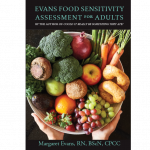
Order the Assessment!
Evans Food Sensitivity Assessment for Adults

This section offers a brief explanation of the physiology related to food sensitivities. It is important to have a basic understanding of the differences between food allergies and food intolerances as this impacts both the method used for identification of the offending food and the treatment that is undertaken.
A more complete explanation of this topic can be found in my book, “Could It Really Be Something They Ate? – The Life Changing Impact of Addressing Food Sensitivities in Children. This book contains all the information you need to determine whether or not food is at the root of your family’s health, behaviour, or learning problems. It then helps you identify the trigger food and supports you to successfully remove this food from your family’s diet.
The digestive system is a complex system involving many different organs. Any illness or injury affecting one part of the system impacts the function of the entire digestive tract.
The digestive process requires the proper balance and interaction of beneficial bacteria, digestive enzymes and hormones.
Food moves along the digestive track by waves of muscle contraction known as peristalsis. It may take 3-5 days for a particular food to travel the full length of the intestine and be eliminated.
Essential nutrients and water are absorbed through the wall of the intestine into the bloodstream and carried throughout the body.
In a normal, healthy bowel, the lining of the small intestine allows absorption of only fully digested particles of food.
If the cells lining the small intestine become irritated or damaged, the wall becomes inflamed and “leaky” and allows partially digested food to be absorbed into the blood stream. These particles may then be the cause of food intolerances and result in symptoms in any organ of the body.
Some individuals may develop a variety of symptoms when they come in contact with common substances in their environment. These can be a food, a chemical or an inhalant and are known as antigens.
The antigen stimulates the body to produce “anti”bodies to weaken and destroy the offending antigen.
The combining of an antigen and an antibody results in the release of histamine. It is an excess of histamine which results in the symptoms we commonly think of being “allergic” in nature such as hives or swelling of the eyes and throat.
Most life threatening reactions to foods and other causes are allergic reactions.
In an allergic reaction, taking an “anti”histamine will result in symptom relief.
Skin testing by an allergist is accurate for the determination of these allergies.
The symptoms of intolerances are not produced by the release of histamine so taking an antihistamine will not improve the symptoms.
The reactions are triggered by local irritation in the digestive track. This irritation results in a “leaky” condition in the small intestine which allows particles of food that have not been completely digested to enter the blood stream. They then circulate throughout the body.
The symptoms of intolerances are varied and can be experienced in almost any part of the body. They also vary from individual to individual.
More than half of the cells of the immune system are found in and around the digestive tract. Because of this, any condition that affects the digestive system also has a profound impact on the immune system.
A diagnosis of food intolerance can not be made by skin test or by a blood test. An elimination of the suspected food from the diet for a trial period of time is the only truly accurate test.
While it is possible to have a fixed reaction in either an allergy or an intolerance, it is more likely that these types of predictable responses are due to a histamine releasing allergy.
The development of symptoms in these types of reactions is very predictable. There is some development of symptoms every time the offending food is eaten.
These reactions are often truly allergic in nature and may require immediate intervention.
Even a very slight contact with the offending substance may produce a large scale response.
Because of the predictable pattern of symptoms, it is usually fairly easy to find the substance that is the cause.
These reactions do not always have a predictable pattern.
This is the most common pattern for food reactions as they are due to food intolerances.
The occurrence of symptoms is determined by a number of factors:
Because of the cyclic nature of the symptoms, identifying the offending substance is often difficult.
Some reactions occur immediately following contact with the offending substance. This accounts for only about 5% of reactions to food.
Immediate reactions are almost always due to a substance causing histamine release due to an allergy rather than an intolerance.
This category includes the immediate and often life-threatening reactions some people have to nuts or shellfish.
Identification of the offending substance is easy to determine.
The reaction that occurs usually involved only 1 or 2 organs of the body.
Because they are often allergic in nature, antihistamines may bring symptom relief.
These reactions may take anywhere from 24 hours to 5 days to develop.
Because of this delay, identification of the offending food may be difficult.
Delayed reactions are far more common that immediate ones.
Symptoms that take a period of time to develop are usually due to intolerances rather than allergies.
Symptoms are not relieved by antihistamines.
Typical reactions include a multitude of chronic complaints. These may include headaches, joint aches, runny nose, ear infections, asthma, bed wetting and behaviour difficulties.
Several chronic conditions such as autism, learning disabilities, asthma and Tourettes have shown improvement when food intolerances and allergies were managed.
Reactions usually involve multiple body systems at one time.
With repeated ingestion of the offending food, the acute symptoms usually diminish to be replaced by a general feeling of chronic fatigue and a multitude of chronic complaints.
When foods causing intolerances are removed from the diet, a period of withdrawal results and symptoms may temporarily worsen.
Following a prolonged period of avoidance of a particular food, an exaggerated reaction may result if the food is eaten. The symptoms previously caused by the food may reoccur in a more dramatic and acute way.
In seeking to improve our health, we must address all aspects of our life—our physical, mental, emotional, and spiritual wellbeing blend together to produce our overall life experience.
Food intolerances are profoundly impacted by our general health and by our stress level. In order to decrease physical symptoms, it is essential to address our “whole” life.
If you imagine a barrel full of water, there is eventually a final drop that causes the barrel to over flow. If you imagine this image as a barrel containing all aspects of your life, it too, can get so full that it overflows and results in serious health concerns.
In dealing with food intolerances, the goal is to keep the barrel at a low enough level that the person can manage the storms and stresses of life without “overflowing” into the realm of symptoms.
Further Reading
« Patent Pending: The Measure of a Life By Wendy Harpham M.D. / Food Addiction And Autism »